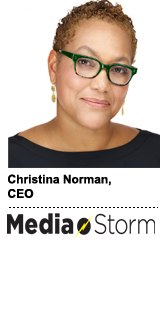 Independent media and entertainment agency Media Storm is deepening its client workbench.
Independent media and entertainment agency Media Storm is deepening its client workbench.
Media Storm specializes in helping network, cable and studio clients such as Starz and CMT increase audience tune-in. Now the agency is broadening its scope to new verticals.
“We’re really starting to use what we learned from the entertainment and media space and apply it to clients in other areas like travel and tourism,” said Christina Norman, CEO of Media Storm.
As more travel, hospitality and CPG brands market directly to consumers, they’re borrowing the audience-building techniques of TV companies, but with the data-driven flair of digital.
Norman, who cut her teeth in the network world, where she served as president of MTV Networks and CEO of OWN, the Oprah Winfrey Network, spoke with AdExchanger about the changing nature of TV and digital planning.
AdExchanger: How has the role of an entertainment and media agency changed?
CHRISTINA NORMAN: It’s about audience. Our job is to identify audiences and use data and the tools to figure out the right message for the right person in the right medium at the right time. We’ve managed to become an expert at it with entertainment brands, but also in the work we’ve done for Celebrity Cruises.
That means being able to not just identify people in the 50-plus demo, but maybe those who’ve taken a cruise before who live in this ZIP code and exhibit these behaviors. To understand the path it takes for someone to convert to book a cruise, you need a lot more touch points along the way. You have to think a lot more consciously about engaging with them. Being more targeted also makes it more of an efficient buy.
After a decade of experience on the TV sell side, what’s changed most, putting on your buy-side hat?
At MTV, it was really audience-first. In the time I was there, the audience was looking for leadership and curation. What I think we really came to was participation. And that’s the place we’re at now, where the consumer wants to have a say, to create and have a dialogue rather than this top-down approach.
What did that tell you about changing consumption habits?
Back in the day, when you saw thousands of kids standing in Times Square holding signs and cheering at the windows during Total Request Live, we realized it was not just about playing videos. This was about engaging them with participation. Now it’s about engaging them where their opinion matters and they don’t just sit passively and accept your programming selections.
What drove the emerging focus on data activation at the network level?
Going back to my days at Viacom, it was always about audience – kids, young adults, country music lovers, alternative music fans. I think at this point, data and attribution have caught up and it’s more about behavior, where I don’t care if you’re 18 to 49, I care if you like this band. It’s what social brought. Social doesn’t care about demo. It cares about behavior.
How is Media Storm becoming more data-driven?
We have our own proprietary data platform called Juba Plus and we do analytics and predictive modeling that’s behavior-based. We’re able to identify areas and opportunities where we can say, “Yes. We know you want to reach X number of people who watch this show, but based on lookalike modeling, what other extrapolations can we make?’’ What does the full universe look like beyond the hand raisers?
Can you give a more specific example?
Without naming names, we had a client earlier this year launching a show that skewed male. When we did analysis for them, we uncovered an opportunity for African-American women based on viewing patterns, the storyline and other attributes. Does that mean they should put 50% of their budget against it? Absolutely not, but we were able to identify that there was an audience here, and if you’re not reaching out, they won’t come otherwise.
What’s the practical benefit of having more access to data in the TV planning process?
I get excited about data and the ability to go narrow and deep with it. The thing I love about software-enabled planning is it does take the guesswork out of things and gives us more opportunities to be creative. Because if you’re used to being hands-on and doing digital-direct deals, there’s so much more we can do programmatically now.
My goal is to figure out how we transform from being a great media planning and buying agency to a holistic marketing services partner for our clients. That’s what I’m hearing their needs are right now. Yes, it’s buying media, but it’s all the stuff that happens before it that matters now.
Interview condensed and edited.
This post was syndicated from Ad Exchanger.

More Stories
Digital Ad Revenue Growth Decelerates Again in 2023, Per IAB Ad Revenue Report
Two new screens for LUMO in Wellington
Digital Ad Revenue Hits New Record in 2023, With CTV Expecting FAST 2024 Growth